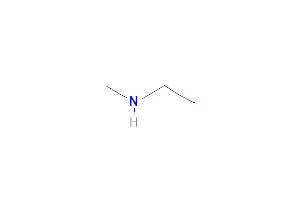N-Ethylmethylamine Information
Chemical Name | N-Ethylmethylamine |
Other Name | N-Ethyl methylamine; Methylethylamine |
CAS | 624-78-2 |
EINECS | 210-862-1 |
Type | Organic intermediates; Organic raw materials |
Molecular Formula | C3H9N |
Molecular Weight | 59.11 |

What is N-Ethylmethylamine?
Methylethylamine (N-methylethylamine), also known as N-methylethylamine or N-ethylmethylamine, is usually processed into hydrochloride salts for storage and transportation due to its low boiling point. This compound has extensive applications in industries such as medicine and chemical engineering.
However, due to its asymmetric structure, small molecular weight and low boiling point, it faces many challenges in the processes of preparation, purification and transportation, which also leads to its relatively high market price. There are not many public reports on the synthetic method of methylethylamine at present. One of the more classic synthetic routes uses ethylamine as the starting material. It reacts with benzaldehyde to generate a Schaffine base intermediate, which is then methylated with methyl iodide. Finally, the target product, methylethylamine, is obtained through a hydrolysis step. This synthetic process involves multiple key steps and reaction condition control, requiring meticulous operation and optimization to ensure the purity and yield of the product.
N-Ethylmethylamine Uses
In the synthetic field of modern chemical industry, there is an important synthetic method, that is, using N-ethylmethylamine as the basic raw material and through specific chemical reactions with acryloyl chloride to synthesize N-ethylmethylacrylamide with specific chemical structures and properties.
Specifically, N-ethylmethylamine belongs to the diamine class of compounds in chemical classification. Dialkyl amines are a class of organic substances with unique chemical structures, and their notable feature lies in the presence of dialkyl amine groups in their molecular structures. In this group, two alkyl groups are closely bonded to the amino nitrogen atom through chemical bonds. This special connection method endows dialkyl amines with a series of unique physical and chemical properties.
In terms of the nature of N-ethylmethylamine itself, it shows the characteristic of being insoluble in water in terms of solubility. This property makes it impossible for it to be evenly dispersed in water, but instead it will form obvious stratification or sedimentation with water and other phenomena. Meanwhile, from the perspective of acidity and alkalinity, N-ethylmethylamine is a strongly basic chemical substance, and this characteristic can be clearly reflected by its pKa value. The pKa value is an important indicator for measuring the strength of the acidity or alkalinity of chemical substances. A higher pKa value of N-ethylmethylamine indicates that it has a strong ability to accept protons in chemical reactions and can undergo neutralization reactions with acidic substances, etc.
It is worth mentioning that N-ethylmethylamine is not rare in nature and is widely present in many common foods. For example, in wild carrots, N-ethylmethylamine, as a trace component, participates in and influences the flavor and nutritional components of carrots; Corn, as an important food crop, also contains a certain amount of N-ethylmethylamine inside. Cabbage, a common vegetable, is also rich in this compound. Also, carrots, whether wild or cultivated, all contain N-ethylmethylamine. Because N-ethylmethylamine is widely present in these foods and its content is relatively stable, it can be used as a reliable biomarker for monitoring and evaluating the intake of these foods in the human body. Through the detection and analysis of N-ethylmethylamine content in the human body, researchers and medical workers can roughly understand an individual's intake of related foods. This is of great significance for studying the relationship between diet and health, formulating reasonable dietary plans, and conducting nutritional assessments, etc.

N-Ethylmethylamine Properties
Melting point | -70.99°C (estimate) |
Boiling point | 36-37 °C (lit.) |
density | 0.688 g/mL at 25 °C (lit.) |
vapor pressure | 8.53 psi ( 20 °C) |
refractive index | n20/D 1.374(lit.) |
Fp | <−30 °F |
storage temp. | 2-8°C |
solubility | Chloroform, Methanol (Slightly), Water |
pka | pK1:4.23(+1) (25°C) |
form | Liquid |
color | Clear colorless to light yellow |
Sensitive | Hygroscopic |




